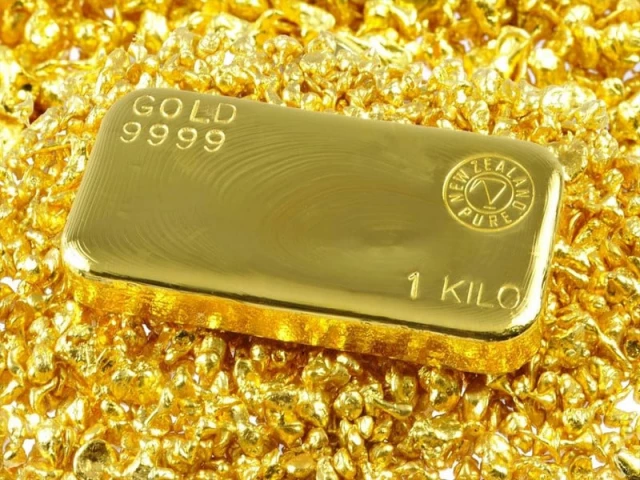Over the last nine months, gold has been on a historic run, delivering one of the strongest rallies in decades. Prices opened 2025 at around $2,624 per ounce or Rs290,000 per tola in Pakistan and have since surged close to $3,895, or Rs410,000, marking a staggering 44% rise year-to-date. This climb, amounting to more than $1,250 in gains within a single year, has stunned market watchers and forced major financial institutions like Goldman Sachs, Citi, and JPMorgan to repeatedly revise their price forecasts upward.
What began as a steady upward grind in late 2023 has morphed into what analysts now call “beast mode,” with gold repeatedly breaking through resistance levels and showing little appetite for meaningful corrections.
This unusual surge comes against a backdrop of geopolitical turmoil, de-dollarization trends, heavy central bank buying, and heightened market uncertainty. But it also coincides with the US stock market hitting fresh highs. According to Forbes, gold and equities have now notched record closes on the same day six times in 2025, an anomaly seen only twice between 1970 and 2023. The dual rally of risk assets and safe havens points to a deeper shift in global capital flows, and possibly a turning point in the international monetary order.
The drivers of gold’s rally
1. Geopolitical risks and global uncertainty
Gold’s reputation as a safe-haven asset has rarely been more relevant. The ongoing Russia-Ukraine war and the escalating Israel-Palestine conflict have created a sense of perpetual geopolitical risk. Additionally, Donald Trump’s return to the US presidency has reshaped global politics, reviving tariff disputes, straining relations with allies, and fueling expectations of more volatile international trade policies. With political risk running high, investors and governments alike have turned to gold as insurance against an uncertain future.
2. Central bank gold buying and de-dollarization
Perhaps the most important structural driver has been the aggressive accumulation of gold by central banks, particularly in China, India, Turkey, and Russia. This buying spree is part of a broader de-dollarisation strategy, as emerging markets seek to reduce dependence on the U.S. dollar in global trade and reserves, said Adnan Agar, Director of Interactive Commodities. According to the World Gold Council (WGC), central banks purchased over 200 metric tons of gold in the first seven months of 2025, a 4% increase from last year. For policymakers wary of Washington’s sanctions-driven financial dominance, gold offers a tangible, finite, and politically neutral reserve asset.
3. The US dollar’s decline
The US Dollar Index has dropped 10% this year, its steepest fall since 2003. A weaker dollar mechanically supports gold prices (since bullion is priced in dollars) and makes US equities more attractive to foreign investors. Analysts like Marko Papic of BCA Research argue that the dollar’s slide stems from fading US fiscal dominance. Pandemic-era stimulus bolstered US household wealth temporarily, but with those funds largely spent and other regions stimulating their own economies, the dollar’s “exceptionalism” is eroding.
4. ETF inflows and retail demand
Beyond central banks, retail investors have poured into gold-backed ETFs. Inflows in the past five months have been some of the strongest on record, reflecting growing scepticism about fiat currencies and global debt sustainability. India and China remain dominant in jewellery demand, while US and European investors are increasingly favouring ETFs over physical bullion.
Historical context: a rare dual rally
Gold’s rise alongside the S&P 500 defies traditional patterns. Historically, gold thrives in times of economic distress, while stocks climb during periods of optimism. The 1970s provide the closest historical parallel. Following Nixon’s suspension of dollar convertibility into gold in 1971, inflation dropped temporarily, fueling equity gains. But when inflation surged again in 1973, the Fed doubled interest rates, triggering a stock market crash while gold soared.
Peter Corey of Pave Finance warns that today’s rally carries similar risks. Inflation has been moderating since 2022, boosting corporate profits and stocks. But should inflation reaccelerate, the Fed may be forced into aggressive tightening, endangering equities while further supporting gold. Investors, he notes, are more sensitive now to Fed policy shifts than they were 50 years ago.
Debt overhang and structural imbalances
The rally cannot be divorced from the unprecedented levels of global debt. US government debt now exceeds $37.5 trillion, or 124% of GDP, compared to just 40% in 1971 when the gold window was closed. Globally, debt has ballooned to $324 trillion, over 235% of world GDP. With central banks constrained, unable to raise rates aggressively without bankrupting governments, nor cut deeply without sinking their currencies, the case for gold as a hedge against systemic financial stress has only strengthened.
Margin debt in equities has also hit a record $1.06 trillion, up 33% from last year. Historically, such leverage spikes have preceded market corrections, underscoring the fragility beneath today’s equity rally. In this context, gold’s rise appears less like speculation and more like a rational hedge against the excesses of debt-fueled growth.
The road ahead: correction or continuation?
Despite its explosive performance, many analysts caution that gold is overdue for a breather. Typically, rallies of this scale are followed by $400–$500 corrections before resuming an upward trend. Technical indicators also suggest that the metal is overbought. A consolidation phase could occur after prices test the psychological $4,000 level, with some profit-taking before another leg higher.
Looking into 2026, forecasts range widely. Some see gold stabilising between $3,600 and $4,000, while more bullish projections, such as those from Interactive Commodities’ Adnan Agar, suggest levels of $5,000–$5,500 are possible if geopolitical tensions persist and central bank demand remains robust. Others, like long-time gold bull Frank Holmes, even project $7,000 per ounce within the next US presidential term, citing unstoppable debt growth and central bank accumulation.
